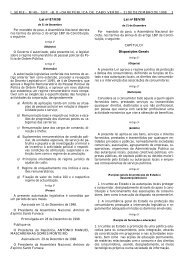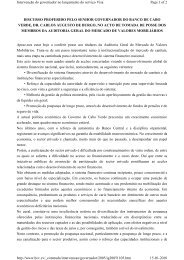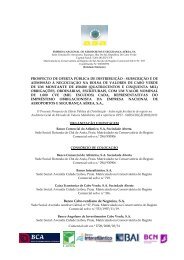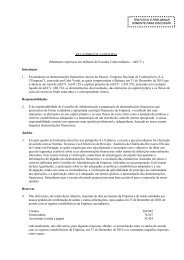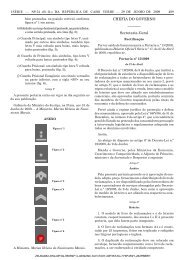Relatorio_final_BAI_10. - Cabo Verde
Relatorio_final_BAI_10. - Cabo Verde
Relatorio_final_BAI_10. - Cabo Verde
You also want an ePaper? Increase the reach of your titles
YUMPU automatically turns print PDFs into web optimized ePapers that Google loves.
.142<br />
<strong>BAI</strong> - Relatório & Contas | 10 - 11. Notas Explicativas às Demonstrações Financeiras<br />
<strong>BAI</strong> - Annual Report | 10 - 11. Explanatory Notes Pertaining to the Financial Statements<br />
Apenas podem ser designados na opção de justo valor os activos<br />
financeiros que cumpram os seguintes requisitos:<br />
Only the financial assets which meet the following requisites can be designated in<br />
the fair value option:<br />
Eliminem ou reduzam significativamente uma inconsistência na mensuração ou no reconhecimento<br />
(por vezes, denominada “uma falta de balanceamento contabilística”);<br />
When they eliminate or significantly reduce a measurement or recognition inconsistency<br />
(also referred to as “an accounting mismatch”);<br />
Um grupo de activos financeiros, passivos financeiros ou ambos é gerido e o seu desempenho<br />
avaliado numa base de justo valor, de acordo com uma estratégia documentada de gestão do<br />
risco ou de investimento, e a informação sobre o grupo é fornecida internamente ao pessoal<br />
chave da gerência da entidade nessa base; ou<br />
a group of financial assets, financial liabilities or both is managed and their performance assessed on a fair value basis in accordance<br />
with a documented risk management or investment strategy and the information on the group is supplied internally to key personnel of<br />
the party’s management on such a basis; or<br />
Se um contrato contiver um ou mais derivados embutidos, que segundo o IAS 39 têm de ser bifurcados.<br />
If a contract has one or more embedded derivatives, which according to IAS 39 should be split.<br />
Os instrumentos financeiros derivados também são classificados<br />
nesta categoria como activos financeiros detidos para<br />
negociação, excepto quando fazem parte de uma relação de<br />
cobertura.<br />
A avaliação destes activos é efectuada periodicamente com<br />
base no justo valor. O valor de balanço dos instrumentos de<br />
dívida que se encontram registados nesta categoria inclui o<br />
montante de juros corridos e não cobrados.<br />
Os ganhos e perdas resultantes de variações de justo valor são<br />
reconhecidas em resultados.<br />
nota2.1.3.<br />
.Crédito e outros valores a receber e provisões<br />
.redit and other amounts receivable and provisions<br />
Os créditos e outros valores a receber compreendem todos<br />
os activos financeiros correspondentes ao fornecimento<br />
de dinheiro, bens ou serviços a um devedor. Este<br />
conceito abrange a actividade típica da concessão de crédito a<br />
clientes, incluindo operações de locação financeira mobiliária<br />
e imobiliária, bem como as posições credoras resultantes de<br />
operações com terceiros realizadas no âmbito da actividade da<br />
instituição e exclui as operações com instituições de crédito.<br />
Financial derivative instruments are also classified in this category as financial<br />
assets held for trading, except when forming part of a hedge.<br />
Such assets are periodically valued on a fair value basis. The balance sheet value<br />
of debt instruments recognised in this category includes the amount of uncharged<br />
accrued interest.<br />
Gains and losses on changes in fair value are recognised in the income statement.<br />
Credit and other amounts receivable include all financial assets corresponding<br />
to the supply of cash, goods or services to a debtor. This concept includes<br />
the characteristic lending operations to customers, including equipment<br />
and property leasing operations, in addition to receivables on operations<br />
with third parties when performed under the scope of an institution’s activity,<br />
excluding operations with credit institutions.<br />
Os créditos e outros valores a receber são inicialmente reconhecidos<br />
pelo valor nominal e não podem ser reclassificados<br />
para as restantes categorias de activos financeiros.<br />
Os juros, comissões e outros custos e proveitos que sejam considerados<br />
incrementais (associados à operação de crédito) são<br />
periodificados ao longo da vida das operações de acordo com o<br />
método pró-rata temporis, quando se tratem de operações que<br />
produzam fluxos de rédito ao longo de um período superior a<br />
um mês, independentemente do momento em que são cobradas<br />
ou pagas.<br />
Os créditos a clientes apenas são abatidos ao balanço quando<br />
expiram os direitos contratuais do Banco à sua recuperação ou<br />
forem substancialmente transferidos todos os riscos e benefícios<br />
associados à sua pertença.<br />
O Banco classifica em crédito vencido as prestações vencidas<br />
de capital ou juros decorridos que sejam trinta (30) dias após o<br />
seu vencimento.<br />
Nos créditos em contencioso são consideradas vencidas todas<br />
as prestações de capital (vincendas e vencidas).<br />
As responsabilidades por garantias prestadas e compromissos<br />
irrevogáveis ou revogáveis são registados em contas extra-patrimoniais<br />
pelo valor em risco, sendo os fluxos de comissões,<br />
juros ou outros proveitos registados em resultados ao longo da<br />
vida das operações.<br />
O Banco avalia regularmente se existe evidência objectiva de<br />
imparidade na sua carteira de crédito. As perdas por imparidade<br />
identificadas são registadas por contrapartida de resultados,<br />
sendo subsequentemente revertidas por resultados caso,<br />
num período posterior, o montante da perda estimada diminua.<br />
Um crédito concedido a clientes, ou uma carteira de crédito<br />
concedido, definida como um conjunto de créditos com características<br />
de risco semelhantes, encontra-se em imparidade<br />
quando:<br />
<strong>BAI</strong> - Relatório & Contas | 10 - 11. Notas Explicativas às Demonstrações Financeiras<br />
<strong>BAI</strong> - Annual Report | 10 - 11. Explanatory Notes Pertaining to the Financial Statements<br />
Credit and other amounts receivable are initially recognised at their nominal value<br />
and may not be reclassified to other financial assets categories.<br />
Interest, commissions and other costs and income considered incremental (i.e.<br />
associated with credit operations) are periodised over the course of an operation’s<br />
lifetime on a pro rata temporis basis, in the case of operations which generate<br />
credit flows over a period of more than one month, notwithstanding the time of<br />
collection or payment.<br />
Loans and advances to customers are only written off from the balance sheet<br />
when the bank’s contractual rights to the recovery thereof expire or when all of<br />
risks and benefits associated with title thereto have been substantially transferred.<br />
The bank classifies overdue payments of capital or interest 30 (thirty) days from<br />
maturity as overdue credit.<br />
When legal proceedings are taken, all capital instalments (outstanding and overdue)<br />
are deemed to have matured.<br />
Liabilities for the issue of guarantees and irrevocable or revocable commitments<br />
are registered in off-balance sheet accounts for the amount at risk, whose commissions,<br />
interest flows or other income are recognised in the income statement<br />
over the lifetime of the operations.<br />
The bank regularly assesses whether there is any objective evidence of impairment<br />
in its credit portfolio. Any impairment losses identified are recognised as<br />
a charge to the income statement and subsequently reversed if, at a later stage,<br />
there is any decrease in the amount of the estimated loss.<br />
Lending to customers or a lending portfolio, defined as being a collection of loans<br />
with similar risk characteristics are considered impaired when:<br />
I - Exista evidência objectiva de imparidade resultante de um ou mais eventos que ocorreram após o seu reconhecimento inicial; e<br />
There is objective evidence of impairment resulting from the occurrence of one or more events after their initial recognition; and<br />
II - Quando esse evento (ou eventos) tenha um impacto no valor recuperável dos fluxos de caixa futuros desse crédito,<br />
ou carteira de créditos, que possa ser estimado com razoabilidade.<br />
When such an event (or events) has/have an impact on the recoverable value of the future cash flows on such credit,<br />
or loan portfolios and when this may be reliably estimated.<br />
143.



